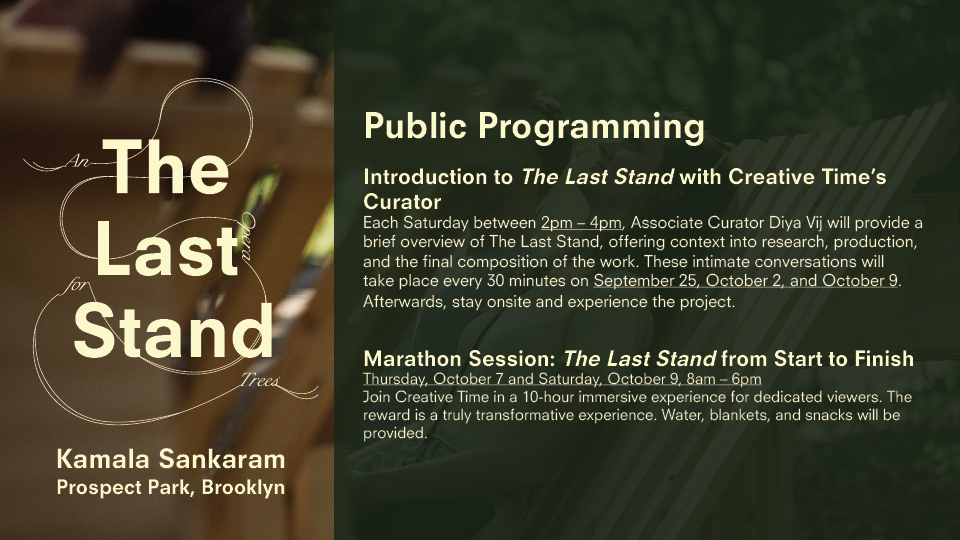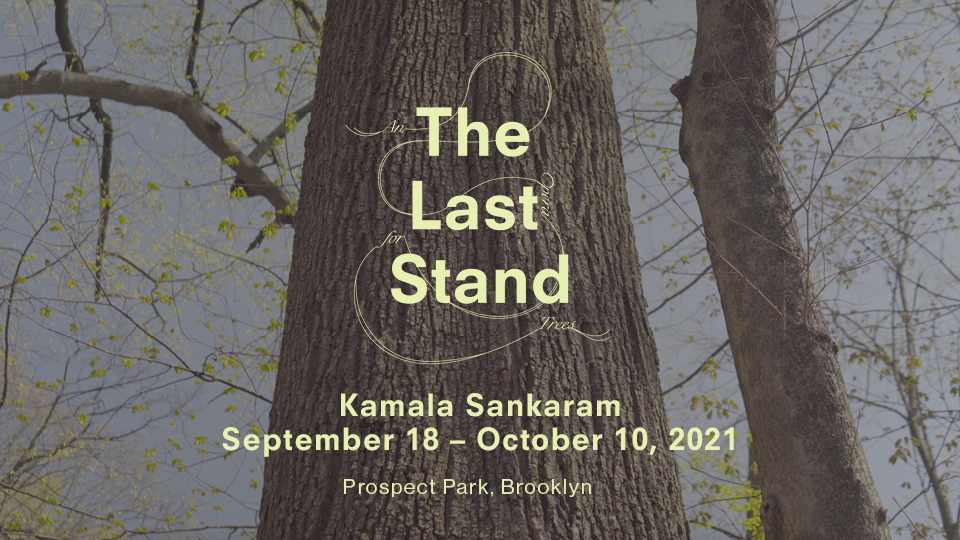THE LAST STAND Digital Program
Through conversations with ecologists, ecoacoustics scientists, and researchers, Kamala Sankaram embarked on a process of field recording plant and animal life in Black Rock Forest. To honor the agency of the wildlife, Sankaram chose not to manipulate or interpret these sonic happenings. Instead, she listened to the forest, a dynamic and complex ensemble on its own. Retaining the original pitch and timing of each element, Sankaram found natural times where the sounds of various elements aligned and grouped them by tempo. In doing so, she devised a formula that rendered one year of the tree’s life equal to approximately two minutes of the composition. Expanding over five parts and ten hours, The Last Stand invites us into 300 years of sonic history exploring the richness of life and memory within the forest’s ecosystem. As the years progress, the drastic shifts in species, weather, and technology are revealed and the loss of life is visceral.
Learn more about the narrative components in The Last Stand below. The composition contains many groupings of sounds that repeat throughout an act or the entirety of the narrative. Throughout this program are descriptions of individual groupings that we refer to as loops. They often appear layered with other sounds and rhythms creating complex tiers of audio that are in motion. While the groupings are just one isolated part of the composition, we hope the descriptions below offer a glimpse into the auditory, both the literal and the poetics of the soundscape.
Join us for the following programs; Introduction to The Last Stand with Creative Time’s Curator every Saturday between 2pm – 4pm, and Marathon Sessions: The Last Stand from Start to Finish on Thursday, October 7 and Saturday, October 9, 8am – 6pm.
Times are approximate.

It is Fall in the forest. The full growth trees release a deluge of acorns. Most are eaten or taken by the squirrels, but one makes its way into the soil.

Accompanied by a Munsee Lenape invocation to nature, the White Oak tree takes root. It grows alongside the repetition of the changing seasons and forest life—an aria by a white throated sparrow, the rhythms of the wolves, and the chorus of a community of frogs. Thunder booms from time to time. The forest is in motion: Revolutionary War cannons launch nearby, settler colonialists overtake the unceded land of the Waoranecks; domesticated farm animals are moved in and the wolves disappear. Horses and carriages fill the new roads of the forest perimeter and the first steam train arrives.
Description of an excerpt of Act I: Air is moving, water is moving. A striking sound: ice is carrying the vibrations of light impact through water below. It’s like a makeshift string instrument is being plucked. Or someone is trying to clear their throat. It echoes and travels away quickly. The calls of a cricket frog have a consistent rhythm (206 beats per minute), creating musical momentum for the ice’s irregularities and the continuity of flowing water. The sound of ice struck over land is more familiar, like a footfall in winter.
Animal Loop Act I: A layering of birdsong styles: a trill sends a note off upward and immediately begins again, a two-toned chirp comes in like a periodic lyric, an echoing crow’s caw, staccato rasps, and a sparrow’s sing-song whistle.

The White Oak grows into the forest’s mother tree, holding knowledge of past climate patterns, hosting a biodiversity of life, and sustaining the forest’s ecosystem with food and nutrients. Inhabitants of nearby mountain houses pick berries. The forest survives a catastrophic fire in 1911. In 1929, Black Rock Forest becomes a research forest, a shift that will ensure its long-term preservation. Nearby, the United States Military Academy West Point expands in footprint and technology, introducing propeller planes in the 1940s. The developments pave the way for the U.S. military to become the world’s largest polluter.¹ By the 1960s, the steam train transitions to diesel, cars fill a newly created highway, and the sky is consumed with the drone of airplanes.
Description of an excerpt from Act II: Something fragile is breaking when struck. A horse exhales a quick purr. A bird exhales a high-pitched call, a two-tone whistle. Horses are moving slowly and the bird adds a third note to its song. A deep vibration shakes the ground. There are metal pangs, like spoons dangling against pots and pans, a clunky windchime.
Animal Loop 1, Act II: The thrumming calls of frogs are ambient in stereo. Over top, closer, a traveling vibration through ice. This is familiar from Act 1, like a string being plucked or flicked with a fast, single echo. These elements are looped just a few times exactly, then they change for new phrases. A pulsing insect buzz fades in and fades out, a different string-like sound.
Animal Loop 2, Act III: These sounds are dampened slightly the way earmuffs take the top off things. There is a hum of highway traffic in the distance. A woodpecker’s sharp staccato strikes are the loudest, some very close. Ambient birdsong far away is joined by a sparrow’s whistle.

There are several schools of thought that mark the start of the Anthropocene Epoch, an unofficial geological time-scale that refers to the era in which climate changes are fueled by human behavior. Some consider its beginnings to be during the Industrial Revolution and specifically with the large-scale burning of fossil fuels and others mark the start in the 1950s, when the carbon impact of humans begins to rapidly accelerate. Here, the Anthropocene correlates with the newly energized mass movements for environmental awareness including large-scale recycling programs and preservation efforts. As this era in the White Oak’s life moves along, life around the tree changes drastically. Seasons shorten and shift in time. The droning sounds of technology infiltrate the air, the bird sounds become less frequent. There are more insects. The storms are more frequent, and they are strong. It rains often.
Description of an excerpt from Act III: A chorus of flying creatures: a fly buzzes very close, a place drones far away, and birds trill and sing at a middle distance. A train far away is braking and it sounds like strings in an orchestra, foreboding drama.
Animal Loop Act III: A percussive motif establishes a consistent rhythm. First, a zipper-like sound: quick tugs followed by a longer pull. The familiar sound of traveling vibrations adds a plucking to the beat. Then a continuous sound, an ambient hiss. Frog calls and dull bird chirps add to the consistency of the beat.

A rolling fire erupts throughout the forest. The White Oak tree emits its last burst of life-giving energy. Acorns fall.
¹ Crawford, N., 2019. The Defense Department is worried about climate change – and also a huge carbon emitter. [online] The Conversation. Available at:
https://theconversation.com/the-defense-department-is-worried-about-climate-change-and-also-a-huge-carbon-emitter-118017





